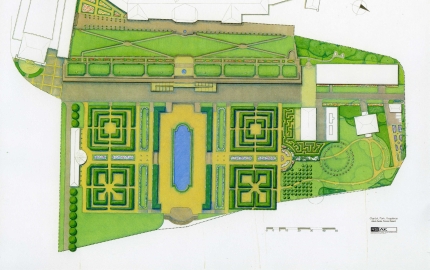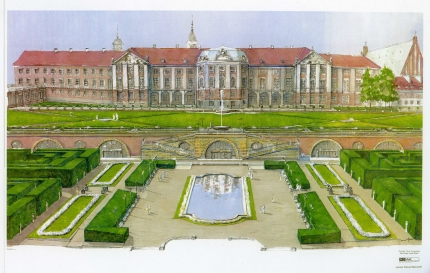- Головна
- Visit
- The Interiors of the Castle and its surroundings
- The Gardens of the Royal Castle in Warsaw
The Gardens of the Royal Castle in Warsaw
The Castle has always had a garden, right from the beginning of its history. It extends over 2.5 hectares of land, from the Castle to the Vistula River, along the steep slope of the escarpment and along its base. It was first planted in mediaeval times, when the Castle still belonged to the Mazovian dukes.
The gardens were extended onto the slopes of the escarpment in the sixteenth century. The transfer of Poland's capital from Kraków to Warsaw at the beginning of the seventeenth century entailed the enlargement of the royal residence and improving the appearance of the gardens. They were filled with fountains and sculptures, cages with birds and unique plant specimens.
In the eighteenth century, at the request of Stanislaus Augustus, the land reclaimed from the river at the base of the escarpment was drained and destined to become part of the gardens. At the beginning of the nineteenth century a huge park, designed by Jakub Kubicki, was laid out there. The busy urban street, which ran along the base of the escarpment; dividing the old, upper garden from the new one at the bottom, was concealed by a tunnel of massive arcades.
In the interwar period, when the Castle once again began to fulfil the most important of its State functions, work was again undertaken to re-establish the long-neglected royal gardens, designing them in a lavish style reminiscent of French Baroque gardens.
The undertaking of the design to return to gardens to their former glory was initiated by the architects, Professor Janusz Bogdanowski and Dorota Uruska-Suszek, and was completed by the landscape architects: Jakub Zemła, Tomasz Zwiech, Dorota Rudawa, Mirosław Sztuka and Dorota Nitecka-Frączyk. The design preserved all traces of the former gardens and, in a creative manner, developed the ideas of its founder.
On May 11, 2019, the Royal Castle in Warsaw solemnly opened its fully reconstructed gardens to the public, gaining a setting worthy of the seat of kings and the Republic of Poland. The gardens return in dialogue with their past, with the tradition of the place and the forms rooted here.
The gardens were extended onto the slopes of the escarpment in the sixteenth century. The transfer of Poland's capital from Kraków to Warsaw at the beginning of the seventeenth century entailed the enlargement of the royal residence and improving the appearance of the gardens. They were filled with fountains and sculptures, cages with birds and unique plant specimens.
In the eighteenth century, at the request of Stanislaus Augustus, the land reclaimed from the river at the base of the escarpment was drained and destined to become part of the gardens. At the beginning of the nineteenth century a huge park, designed by Jakub Kubicki, was laid out there. The busy urban street, which ran along the base of the escarpment; dividing the old, upper garden from the new one at the bottom, was concealed by a tunnel of massive arcades.
In the interwar period, when the Castle once again began to fulfil the most important of its State functions, work was again undertaken to re-establish the long-neglected royal gardens, designing them in a lavish style reminiscent of French Baroque gardens.
The undertaking of the design to return to gardens to their former glory was initiated by the architects, Professor Janusz Bogdanowski and Dorota Uruska-Suszek, and was completed by the landscape architects: Jakub Zemła, Tomasz Zwiech, Dorota Rudawa, Mirosław Sztuka and Dorota Nitecka-Frączyk. The design preserved all traces of the former gardens and, in a creative manner, developed the ideas of its founder.
On May 11, 2019, the Royal Castle in Warsaw solemnly opened its fully reconstructed gardens to the public, gaining a setting worthy of the seat of kings and the Republic of Poland. The gardens return in dialogue with their past, with the tradition of the place and the forms rooted here.
dr Małgorzata Szafrańska
below: plan and view of the garden























